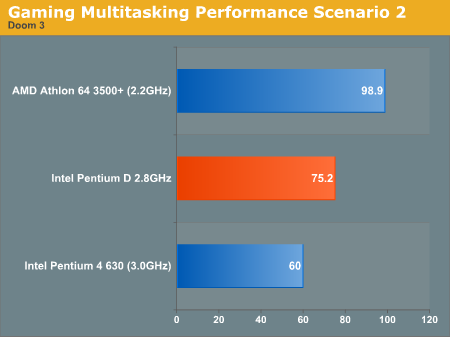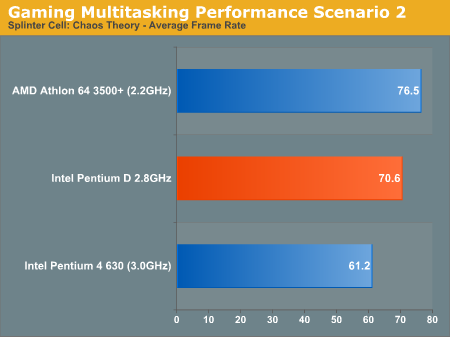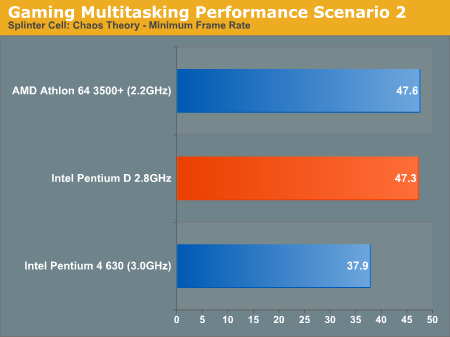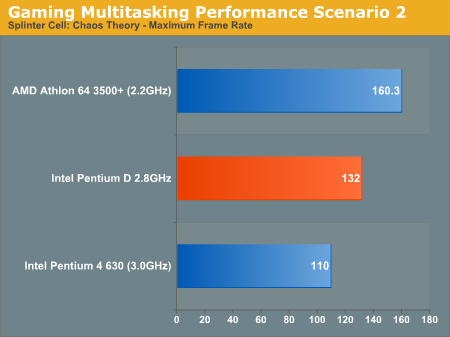Intel Dual Core Performance Preview Part II: A Deeper Look
by Anand Lal Shimpi on April 6, 2005 12:23 PM EST- Posted in
- CPUs
Gaming Multitasking Scenario 2: DVD Shrink
For our next test, we wanted to do something a little less strenuous, so we only ran one background task: DVD Shrink. We left DVD Shrink at its default low priority and went ahead with our benchmarks:

Thanks to DVD Shrink behaving and running with a low priority, our gameplay was largely unaffected on the Athlon 64. The performance dropped less than 3% in Doom 3.
What's very interesting, however, is that the Pentium 4 630 takes a huge performance hit with DVD Shrink running in the background. Despite being set to a low priority, since Hyper Threading allows both the DVD Shrink thread and Doom 3 thread to execute concurrently, they both contend for the same microprocessor execution resources. This happens to be one case where Hyper Threading is actually very bad for performance, as the OS has no idea that its scheduling is actually hurting the CPU's performance severely.



The performance gap between the Pentium D and the Athlon 64 actually closes quite a bit under Splinter Cell. The minimum frame rates are now identical, although the maximum frame rates are clearly higher on the AMD system.
Once again, HT has a negative impact in this case on the Pentium 4 630.
Just for kicks, we decided to turn off DVD Shrink's low priority setting to see what impact that would have on performance. The low priority mode of DVD Shrink basically makes it transparent to gaming. Unchecking this option definitely changes things, it wouldn't even start on the Athlon 64 system.
It eventually ran on the Pentium D system after waiting several minutes for it to start, and even then, performance wasn't acceptable. It just goes to show you that dual core isn't Superman; it does have its limits.










106 Comments
View All Comments
stephenbrooks - Wednesday, April 6, 2005 - link
#55 yes, that would be my best bet on what Anand was implying. AMD's 90nm process is impressive on power efficiency.bdchambers79 - Wednesday, April 6, 2005 - link
Hmm... if permormance isn't the only metric for dual-core AMD, then perhaps power also plays a role? What if they could craft a 2.2gHz monster that had the same power draw as a 2.0gHz a64? Such a beast, besides being a processing power-house, would show extreme overclock potential.cHodAXUK - Wednesday, April 6, 2005 - link
'The move down to 90nm really cut down AMD’s power consumption a lot, to the point where the 90nm Athlon 64 3500+ actually consumes less power under full load than the Pentium 4 630 at idle.'ROFL, I expect the old Prescott space heater gags to start again after this review :)
Crassus - Wednesday, April 6, 2005 - link
Hey Anand,on page 13 top diagramm it says "Thanks to DVD Shrink behaving and running with a low priority, our gameplay was largely unaffected on the Athlon 64. The performance dropped less than 3% in Doom 3. ..." yet the graph shows the A64 at the bottom far behind the Pentiums. Is the graph messed up or the comment?
Great article though and thatnk you for listening to your readers.
Thanks also for the NCQ-page. I still wonder if you want to pick up where you left off some months ago and look into RAID in more detail, possible measuring the impact of NCQ on the benefits of SMT or vice versa and CPU-load issues with simple RAID5 setups on dual-core?
Cheers, Crassus
Lonyo - Wednesday, April 6, 2005 - link
#50 and JeffLet's just say that the dual core Athlon 64 running at 2.2GHz won't be compared to a dual core Pentium D running at 2.8GHz.
AMD's dual core will be quite impressive, even more so than Intel's. Don't look at performance as the only vector to measure though...
....PRICE.
I think you were spot on. 2.2GHz DC Athlon is almost certain NOT to compare to PD2.8GHz.
The article is comparing 3 systems with the same price processor.
The comments from Anand suggest that the 2.2GHz AMD DC will blow the 2.8GHz PD away, but at a higher price.
The 1.8GHz AMD DC is more likely to be comparable (and possible faster, if the 2.2GHz Athlon really is amazing). But who knows?
coldpower27 - Wednesday, April 6, 2005 - link
Tomshardware was able to overclock the Pentium EE 3.2GHZ Dual Core to 3.8GHZ, and 4GHZ on some exotic form of cooling.coldpower27 - Wednesday, April 6, 2005 - link
Rumors indicate AMD's aiming for a launch at 1.8GHZ - 2.2GHZ frequencies for the Athlon 64 Dual Cores, I would guess, that most likely that these Dual Cores are based on the San Diego cores, as they each have access to 1MB of cache with a die surface area slightly larger then Clawhammer.Another guess would be they would use the 2.2GHZ Dual Cores as their FX flagship and have the 1.8GHZ/2.0GHZ variants as their mainstream line.
However with AMD saying 2H 2005 for their Dual Cores, we won't have to wait too long then for Intel's new version of Dual Core in 1H 2006 on the 65nm process.
Maybe the 2.2GHZ Athlon 64 Dual Core is much more expensive then the 2.8GHZ Pentium D? Or it competes with Intel's Pentium D 3.2GHZ.
defter - Wednesday, April 6, 2005 - link
Great review! It is refreshing to see different kinds of benchmarks.The problem with dual core Athlon64 is that it won't be launched until 2006 according to the AMD's roadmap: http://www.amd.com/us-en/Processors/ProductInforma... (dual core Athlon64 FX will be launched in H2 2005, but no regular dual core Athlon64 is scheduled for 2005)
And in 2006, Intel will have 65nm dual core chips available...
PrinceXizor - Wednesday, April 6, 2005 - link
For those saying that Intel will have ANOTHER dual core system out because of the delay by AMD...remember...this was a technology PREVIEW. There is no released hardware yet.Its going to be interesting to see what the benefits of AMD's built from the ground up to be multi-core approach vs. Intel's patch job (I still have utmost respect for Intel, they created one fine "patch job" under a severe time constraint, sometimes it does pay to be a behemoth ;)) will be.
P-X
NetMavrik - Wednesday, April 6, 2005 - link
Don't take this post the wrong way, I am not knocking Intel's HyperThreading, but I think most people have actually forgotten what it is. It is not a feature of the Pentium 4, but a bandaid approach to keep their now 31 stage pipeline busy doing something. The reason that a 3.8GHz P4 doesn't run circles around a 2.6GHz A64 is that horribly designed 31 stage pipeline. AMD can't implement some form of HyperThreading because it doesn't have a bunch of processor stages sitting around doing nothing like a P4 does without HyperThreading.